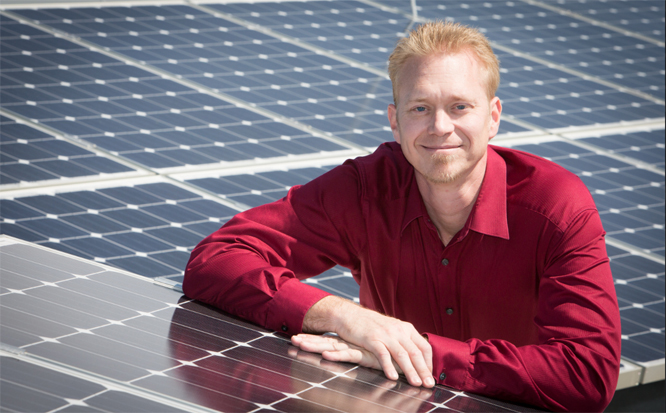
By Mary Gunderson-Switzer

Jim Leidel works every angle of energy independence. He’s currently focused on developing a natural gas-driven combined heat and power (CHP) system. The CHP uses a gas turbine to generate electricity; the waste heat is then used to generate steam/hot water.
Imagine a building that uses the earth for all its heating and cooling needs.
Supplying its electrical needs around the clock, it captures and stores the sun’s energy during the day. On winter days when heat’s needed, its engineers fire up a gas turbine to supply that heat, while generating additional electricity.
Ideally, this environmentally debt-free building wouldn’t need an amp of commercial power.
Jim Leidel is energized about making this happen at Oakland — one system at a time.
“We’re a work in progress,” says Leidel, director of the School of Engineering and Computer Science’s Clean Energy Research Center (CERC).
Leidel helped create the 22,000-square-foot CERC, home to clean (renewable) energy research and development (R&D). Multiple projects are completed or in various stages of development.
The CERC is uniquely situated in “Automation Alley” (Macomb/ Oakland/Wayne counties), which comprise 40 percent of the state’s population and a majority of its economic activity. The CERC fosters commercial partnerships and allows for technology transfer within OU’s R&D community.
That’s good news for Michigan.
Buildings consume about 40 percent of the nation’s energy; in Michigan, that’s about $12 billion annually in energy costs, much flowing out of state.
With a background in mechanical engineering and years working within industry, Leidel also served 10 years as energy manager for OU’s Facilities Management Department.
His research projects demonstrate technologies that can serve as national models in energy-efficient buildings; utilization of solar power; wind and biomass (organic materials) energy; and combined heat and power systems.
Detroit Edison provides electricity to Oakland, but OU has its own micro-grid, allowing distribution of power generated by these new clean energy technologies.
For instance, CERC’s steam boiler was replaced with a woodchip boiler fed from on-campus urban waste wood. Bioethanol/ biomass pelletization equipment will also be installed so students can learn more about biofuel technologies production.
Leidel works every angle of energy independence. He’s currently focused on developing a natural gas-driven combined heat and power (CHP) system. The CHP uses a gas turbine to generate electricity; the waste heat is then used to generate steam/hot water.
Wind is another power-generating alternative. Leidel has studied utility-sized, multi-megawatt wind installations on campus and submitted a proposal for this new technology.
Back in 2003, Leidel designed a 10kW integrated photovoltaic (PV) system for OU’s student apartment roof. Electricity produced from the Uni-Solar shingles is used by the building or fed back to the university’s power grid.
Today, in addition to using solar capabilities to generate electricity, OU has something new under the sun.
Oakland’s geothermal/solar thermal Human Health Building (HHB) is a first among firsts.
It’s Michigan’s first college campus building to achieve a LEED Platinum rating — the highest rating — due, in part, to a $2.7 million U.S. Department of Energy grant.
A majority of the grant was used for two components: a desiccant dehumidification system and a newer-tech variable refrigerant flow heat pump system. The HHB project is the first of its type or size in the nation to use both systems.
The heat pump system uses the ground to cool water circulating within the building. The pump can be used both in heating the building in wintertime and as a heat sink in cooling it in summertime. This revolutionary dehumidification cooling system is powered by one of the nation’s largest solar thermal energy systems.
The HHB carbon footprint will be reduced, and energy costs are expected to be cut in half.
What originally brought him to Detroit was a patent for a low- heat rejection automotive engine design. This entrepreneurial spirit makes for additional good, clean fun. His students enjoy CERC projects that include solar and fuel cell golf carts and electric car conversion.
Clearly, Leidel’s expertise on energy efficiency — much like sunlight falling on the buildings he modifies — isn’t being wasted.